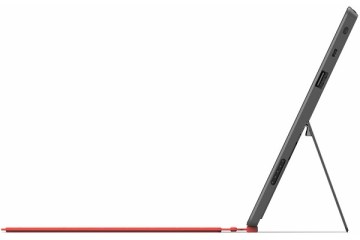Microsoft’s mystery event turned out to be the announcement for Microsoft Surface, a pair of Windows 8 tablets made by the company and scheduled to launch later this year.
Microsoft is recycling the Surface name–previously used for the company’s large touch screen setups–for two tablets with 10.6-inch touch screens. Both tablets are encased in magnesium, and have built-in stands that unfold from the back side of the device. A separate screen cover includes a full multi-touch keyboard and trackpad on its underside, essentially turning the tablet into a laptop.
(MORE: My First 23 Questions About Microsoft’s ‘Surface’ Windows 8 Tablet)
The main difference between the two Surface tablets is the type of processor and corresponding version of Windows that each one uses. One tablet uses an Intel Ivy Bridge processor and comes with Windows 8 Pro, which allows it to run legacy Windows programs and Metro-style apps from the Windows Store.
The other tablet will use Nvidia’s Tegra 3 chip and run Windows RT, a separate version of Windows for ARM-based processors. It will be thinner, lighter and less expensive than the Intel-based (x86) tablet. (Microsoft hasn’t announced pricing for Surface tablets, but says the ARM-based version will cost about the same as competing tablets, while the Intel-based tablet will cost roughly the same as Ultrabook laptops.)

With previous versions of Windows, Microsoft only made the software, and left the hardware to companies like HP and Dell. Other companies will still be able to make Windows 8 laptops, tablets and hybrids, but Microsoft now sees an advantage in designing its own hardware–an obvious nod to Apple’s success with the iPad. It’s unclear how other hardware makers will respond, or whether they even knew this was coming, as the nature of the Surface event was kept secret from the press until they arrived.
Microsoft says the ARM-based version of Surface will launch alongside Windows RT and Windows 8–probably around October, according to unconfirmed reports–and the x86 version will launch 90 days later.
My colleague, Harry McCracken, was at the launch event, where Microsoft provided hands-on time with Surface. Stay tuned for his impressions, and check out the list of specs for Microsoft Surface below:
Microsoft Surface with Windows RT
- Screen Size: 10.6 inches
- Weight: 1.49 pounds
- Thickness: 0.37 inches
- Ports: MicroSD, USB 2.0, Micro HDMI
- Storage: 32 GB or 64 GB
Microsoft Surface with Windows 8 Pro
- Screen Size: 10.6 inches
- Weight: 1.99 pounds
- Thickness: 0.53 inches
- Ports: MicroSDXC, USB 3.0, Mini DisplayPort
- Storage: 64 GB or 128 GB

